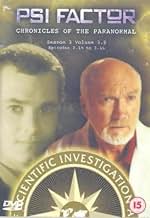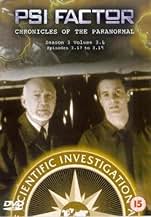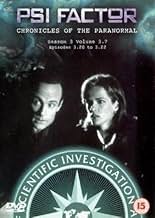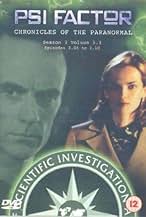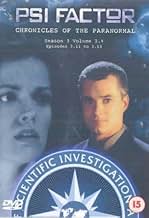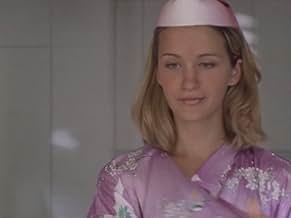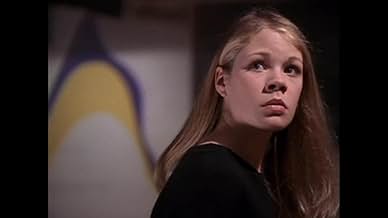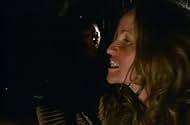IMDb रेटिंग
7.1/10
2 हज़ार
आपकी रेटिंग
अपनी भाषा में प्लॉट जोड़ेंA science team that works for the Office of Scientific Investigation and Research (O.S.I.R.) investigates the reports of supernatural phenomena.A science team that works for the Office of Scientific Investigation and Research (O.S.I.R.) investigates the reports of supernatural phenomena.A science team that works for the Office of Scientific Investigation and Research (O.S.I.R.) investigates the reports of supernatural phenomena.
- पुरस्कार
- 1 जीत और कुल 5 नामांकन
एपिसोड ब्राउज़ करें
फ़ीचर्ड समीक्षाएं
Psi Factor rode a rough road in its 4 years as a series. Conceived as a series based on the purportedly real organization of the OSIR, the stories were supposedly inspired by real life incidents investigated by the organization.
In its first year, the series used a docudrama format, with two 1/2 hour stories a week. They gave the major facts of a case, and the investigators were mostly there to present the story, and not to be active participants. In a lot of ways, while it was interesting, it was not necessary compelling. In two separate episodes, however, they used a single episode format, and the stories presented offered a great more promise than the rest of the episodes that season.
In order to keep the series alive, the producers changed the format for the second season, killing off a major character in the first season finale, and introduced two new character in the first episode of second season. The new characters were Matt Praeger (Matt Frewer) and Michael Kelly (Michael Moriarty)--one, a flippant criminologist with a background in mechanical engineering, and the other, a conspiracy theorist.
Matt Praeger took over the "A" team of the OSIR: the characters who survived the cast culling from first season: Peter Axon (Barclay Hope); Lindsay Donner (Nancy Ann Sakovich); Anton Hendricks (Colin Fox) and a myriad of secondary characters: Claire Davidson (Soo Garay); Lennox Q. Cooper (Peter Blais); Ray Donahue (Peter MacNeill) and Frank Elsinger (Nigel Bennett).
While the series survived through three additional seasons, more changes were instituted, including fourth season characters going missing, the introduction in fourth season of Mia Stone (Joanne Vannicola) and more intimate storylines [with less investigating team members].
The most disturbing change for many fans was the killing off on first season character, Connor Doyle. Many fans were extremely upset at the character's demise, making him very sorely missed for the rest of the show's run. Producers tried to make up for the loss several times, but logistics prevented them from bringing back Paul Miller until near the end of fourth season, where an episode entitled "Regeneration" brought him back to bring some closure to his character's demise.
Overall, the series had some promise, and while it didn't live up to its full potential, there were some promising episodes, and characters that were interesting and full of energy.
In its first year, the series used a docudrama format, with two 1/2 hour stories a week. They gave the major facts of a case, and the investigators were mostly there to present the story, and not to be active participants. In a lot of ways, while it was interesting, it was not necessary compelling. In two separate episodes, however, they used a single episode format, and the stories presented offered a great more promise than the rest of the episodes that season.
In order to keep the series alive, the producers changed the format for the second season, killing off a major character in the first season finale, and introduced two new character in the first episode of second season. The new characters were Matt Praeger (Matt Frewer) and Michael Kelly (Michael Moriarty)--one, a flippant criminologist with a background in mechanical engineering, and the other, a conspiracy theorist.
Matt Praeger took over the "A" team of the OSIR: the characters who survived the cast culling from first season: Peter Axon (Barclay Hope); Lindsay Donner (Nancy Ann Sakovich); Anton Hendricks (Colin Fox) and a myriad of secondary characters: Claire Davidson (Soo Garay); Lennox Q. Cooper (Peter Blais); Ray Donahue (Peter MacNeill) and Frank Elsinger (Nigel Bennett).
While the series survived through three additional seasons, more changes were instituted, including fourth season characters going missing, the introduction in fourth season of Mia Stone (Joanne Vannicola) and more intimate storylines [with less investigating team members].
The most disturbing change for many fans was the killing off on first season character, Connor Doyle. Many fans were extremely upset at the character's demise, making him very sorely missed for the rest of the show's run. Producers tried to make up for the loss several times, but logistics prevented them from bringing back Paul Miller until near the end of fourth season, where an episode entitled "Regeneration" brought him back to bring some closure to his character's demise.
Overall, the series had some promise, and while it didn't live up to its full potential, there were some promising episodes, and characters that were interesting and full of energy.
I was really amazed at how long this show lasted. Sure, it was only four seasons, but as a show that was constantly (unfairly) dismissed as a lame X-FILES wannabe, the fact it lasted as long as it did is pretty surprising. The first season remains my favorite, with the show's original pseudo-documentary approach to stories inspired by real-life cases investigated by the Office of Scientific Investigation and Research. With it's blue-tinted witness interview footage, documentary-like feel, and two story-per-episode structure, PSI FACTOR offered up some intriguing stories for those interested in the world of the paranormal and supernatural. Paul Miller and Maurice Dean Wint alternated as lead investigators Professors Connor Doyle and Curtis Rollins, respectively, though Doyle proved to be the most popular character of the show, despite his forced departure at the end of the first season. Rollins took a leave of absence midway through the season, but would return for the forth (and final) season. The lovely Nancy Anne Sakovich, Colin Fox, and Barclay Hope rounded out the team of investigators as specialists in a specific field.
The second season saw the inclusion of genre veteran Matt Frewer as Matt Praeger, a more skeptical character who was brought in by the O.S.I.R. as Doyle's replacement, and though he was okay, he still couldn't fully replace Doyle. His character's skepticism brought a feeling of "here we go again" to the show, having to sit through yet another character who doesn't believe in much. That was what was so refreshing about Doyle; he always had an open mind about things and believed in anything until the evidence (if there was any) proved otherwise. Despite the lacking of some elements Frewer's Praeger had in comparison to Doyle, the second season still came out pretty good, with many standout episodes, though the show lost the documentary feel many fans loved from the first season and took on a more straight forward storytelling approach, as fell as focusing the entire hour on one story.
With the third season, the show took a turn for the worst as it made the same mistake X-FILES made: things began to focus more and more on internal conflicts within the O.S.I.R., headed up by Nigel Bennet as Elsigner. It was a shame to see the show make such a change when it had been doing just fine telling entertaining stories about paranormal/supernatural investigation. Instead, characters began having hidden agendas and there was internal conspiracies among the O.S.I.R. high-ranking officials. Following Frewer's (rather interesting) departure, the forth season attempted a return to the feeling of the first two years. Even the blue-tinted interview segments return for one episode, and an attempt to wrap up the mystery surrounding Connor Doyle's departure was featured in one of the season's few best episodes. But by the time the forth season was over, the show was gone, and it was such a shame, because it started out great and ended as a hollow shell of its former self. Much like how it appears X-FILES will end.
The second season saw the inclusion of genre veteran Matt Frewer as Matt Praeger, a more skeptical character who was brought in by the O.S.I.R. as Doyle's replacement, and though he was okay, he still couldn't fully replace Doyle. His character's skepticism brought a feeling of "here we go again" to the show, having to sit through yet another character who doesn't believe in much. That was what was so refreshing about Doyle; he always had an open mind about things and believed in anything until the evidence (if there was any) proved otherwise. Despite the lacking of some elements Frewer's Praeger had in comparison to Doyle, the second season still came out pretty good, with many standout episodes, though the show lost the documentary feel many fans loved from the first season and took on a more straight forward storytelling approach, as fell as focusing the entire hour on one story.
With the third season, the show took a turn for the worst as it made the same mistake X-FILES made: things began to focus more and more on internal conflicts within the O.S.I.R., headed up by Nigel Bennet as Elsigner. It was a shame to see the show make such a change when it had been doing just fine telling entertaining stories about paranormal/supernatural investigation. Instead, characters began having hidden agendas and there was internal conspiracies among the O.S.I.R. high-ranking officials. Following Frewer's (rather interesting) departure, the forth season attempted a return to the feeling of the first two years. Even the blue-tinted interview segments return for one episode, and an attempt to wrap up the mystery surrounding Connor Doyle's departure was featured in one of the season's few best episodes. But by the time the forth season was over, the show was gone, and it was such a shame, because it started out great and ended as a hollow shell of its former self. Much like how it appears X-FILES will end.
This is the best 'Sci-Fi' and 'paranormal' T.V series to have hit the screens. It deals with all paranormal activity and explores more themes than the regular X-Files. The special effects are great, so don't miss it.
The show started out great, but the 4th season drifted down some odd rabbit trail. What was up with episode 21!? That was so out of character for both Donner and Axton. Until the final episode season 4.....what the hell was that all about!!? It made totally no since at all. I watched it twice and still it left me confused.
I like Psi Factor better than X-Files because it really happens. After you watch X-Files series, no matter how amazing or terrific it is, you'll end up saying: it's only movie. But, every time I watch Psi Factor... it opens up my mind that so many things, that I couldn't even imagine, exists. So, you think you already know and see everything... watch this series, you'll find out there is a lot more you don't know.
क्या आपको पता है
- ट्रिवियाDEFINITION: "PSI Factor" - In anomalistics, the unquantifiable unknown aspect of an anomalous (paranormal) phenomenon.
- भाव
Matt Praeger: Between doing her hair in ponytails and swooning over the Backstreet Boys, it seems my daughter's been dabbling in witchcraft. But apparently it's okay, see, because it's the good kind.
- कनेक्शनReferenced in Witchouse II: Blood Coven (2000)
टॉप पसंद
रेटिंग देने के लिए साइन-इन करें और वैयक्तिकृत सुझावों के लिए वॉचलिस्ट करें
- How many seasons does PSI Factor: Chronicles of the Paranormal have?Alexa द्वारा संचालित
विवरण
- रिलीज़ की तारीख़
- कंट्री ऑफ़ ओरिजिन
- आधिकारिक साइट
- भाषा
- इस रूप में भी जाना जाता है
- Psi factor: Crónicas de lo paranormal
- फ़िल्माने की जगहें
- उत्पादन कंपनियां
- IMDbPro पर और कंपनी क्रेडिट देखें
इस पेज में योगदान दें
किसी बदलाव का सुझाव दें या अनुपलब्ध कॉन्टेंट जोड़ें

टॉप गैप
By what name was PSI Factor: Chronicles of the Paranormal (1996) officially released in India in English?
जवाब
